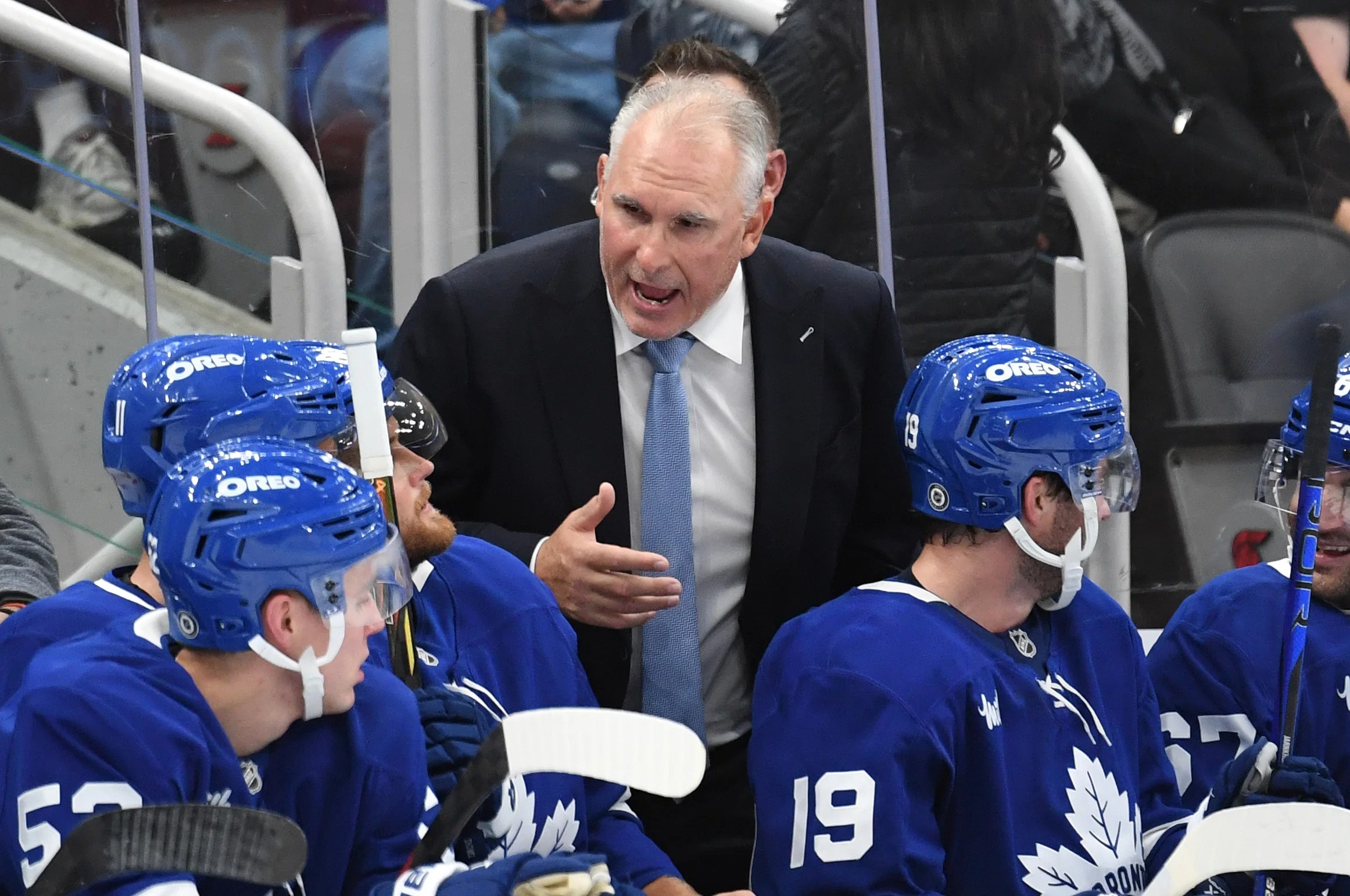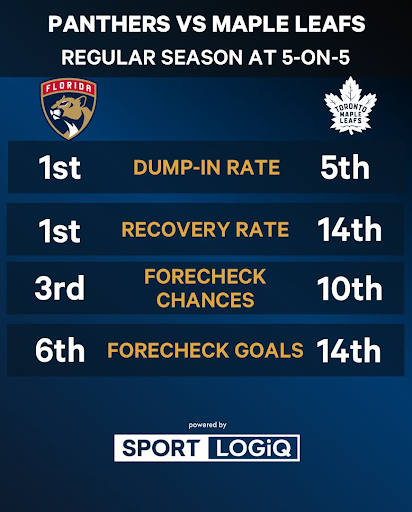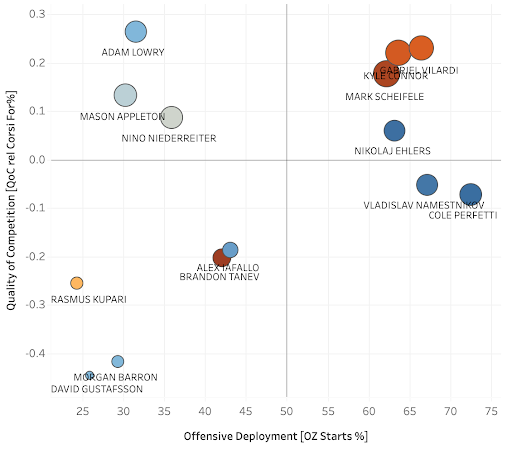NHL training camps have officially begun, and preseason games are right around the corner.
In Toronto, there wasn’t a ton of change compared to last season from a sheer volume perspective. The Leafs are running back the same goaltending duo and top six defensemen, and essentially acquired three new forwards, with some depth additions sprinkled in, while losing Mitch Marner, Pontus Holmberg, and Max Pacioretty.
It’s not a lot of change in terms of quantity, but because Marner played so much and in every situation, replacing those minutes and production is naturally receiving a lot of attention. While the line combinations will be debated for months to come — and they do matter — today, I’m more focused on the Leafs‘ play on the ice at five-on-five this upcoming season.
The Leafs’ puck possession at five-on-five in 2024-25
As the second half of the schedule wore on last season, we constantly flagged the Leafs‘ inability to control the play at evens. It came to a head in Game 7 against Florida, who out-attempted the Leafs a ridiculous 25-0 to start the series-deciding game.
Over the full season, the Leafs finished 29th in five-on-five shot attempt share and 23rd in expected goals. They defended well — by packing the house and clearing the net — and combined with their excellent goaltending tandem, it led to a second-place ranking in five-on-five save percentage. From January onwards, when they posted the second-best points percentage in the league, the Leafs were also buoyed by the third-ranked power play.
Compare those five-on-five numbers to the Panthers, who finished second in both shot-attempt share and expected goals last season. In the second half of the season, when Matthew Tkachuk barely played and Florida began resting players to prepare for the playoffs, they still finished second in the league in goals against per game. The Panthers were very process-driven — dominating the puck, miserable to score against.
When Craig Berube won the Cup back in 2019, his Blues team was similar. They dominated the second half of the season, from January 1 to the playoffs, posting the following numbers:
- 30-10-5 record
- 1st in points (65)
- 1st in 5v5 goal share (59.88%)
- 1st in HDCF% (57.95%)
- 4th in SV% (.934%)
- 2nd in the NHL in xG% (56.26%)
This is the ultimate goal for the Leafs, but they need to improve drastically, given that they were one of the worst teams in the league at possessing the puck at five-on-five last season.
While most of the mainstream media have been falling all over themselves asking questions about Marner leaving, hardly anyone has asked about the team’s lack of puck possession last season. Jonas Siegel is the only one to do it (from what I’ve seen), and Berube responded with the following answer:
“Yeah, I think our forecheck is a big part of it. Our forecheck, from a quick-strike standpoint, was very good. I thought that we didn’t secondary forecheck enough, in keeping pucks alive in the O-zone, to create more O-zone time. And I think we can do a better job of that. And that’s our (defense) included, hedged up and killing more plays in the O-zone. That’s where it starts for me. The shot attempts for sure can go up, and they will go up. I think our D can do a better job of getting more pucks to the net, too. We gotta shoot pucks quicker. It’s got to be a first option.”
There is some merit to Berube’s logic. The team tried to forecheck more last season and were ~ okay at it, but it certainly wasn’t a dominant forecheck. Almost all of their five-on-five goals against the Panthers early in the series came off the rush. When the Panthers shut down the neutral zone, the Leafs created little offense, and the Panthers took over the series.
In essence, the Leafs tried to forecheck a lot (fifth in dump-in rate), but they were only slightly above average at it (14th in recovery rate). To Berube’s point, they were legitimately good at creating chances off of it (10th in forecheck chances), but they didn’t sustain enough pressure or offensive-zone time. While they were effective at creating the initial turnover, they struggled to keep the puck in the zone for second, third, and fourth chances, or grind the puck in the offensive zone and keep it away from their end.
The Leafs’ 2025-26 personnel shift
Now entering Berube’s second season on the job, we’re seeing the Leafs’ lineup align more with the dynamic in St. Louis, with a power forward type on each line. Generally speaking, Berube’s forward units fell along these lines in the 2019 playoffs:
Schwartz-Schenn–Tarasenko
Blais-O’Reilly-Perron
Maroon-Bozak-Thomas
Barbashev–Sundqvist-Steen
Additionally, the Blues also played the 6’4 Zach Sanford in 60 regular-season games, plus eight playoff games. There were also a few smaller, skilled players similar to the Leafs’ own.
In 2025-26, the Leafs will run one of the biggest groups of left wingers in the league: Knies – McMann – Joshua – Lorentz. There’s a forechecker on each line, and the right winger is a skilled type: Domi – Nylander – Maccelli – Robertson.
Can they systemically leverage this dynamic so that the left winger is generally generating speed to effectively forecheck, and the right winger works to make plays with the puck and keep it in the offensive end more?
Unlike his Blues teams, Berube also has more top talent at forward at his disposal in Toronto. Obviously, nobody in St. Louis came close to Matthews’ career production, or John Tavares’, and probably not William Nylander’s, either. The Blues’ biggest star was Vladimir Tarasenko, who finished 13th in points and tied for seventh in goals.
St. Louis built out their depth, with 13 double-digit goal scorers (the Leafs had seven all of last season, and acquired Scott Laughton, who would be their eighth). Eight Blues forwards were at or above .49 points per game, plus Maroon’s 17 in 43 and Ivan Barbashev’s 16 in 45. Alex Steen chipped in 12 in 34, and Sanford added 11 in 37.
It’s a little funny to reflect on now, but Berube outcoached Paul Maurice in the first round of 2019. When the Jets’ season was on the line in Game 6, Berube’s Blues held them to just six shots on net in the first 40 minutes of the game as they built a 3-0 lead and secured the series victory.
As it was a four-line team, Berube deployed the Blues a lot differently than the Leafs’ top-heavy group last season. The difference in these charts provides a visual: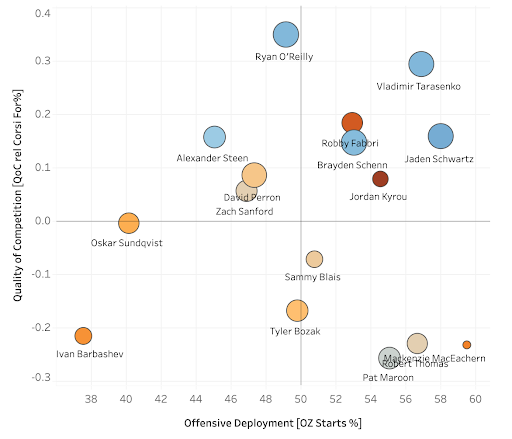
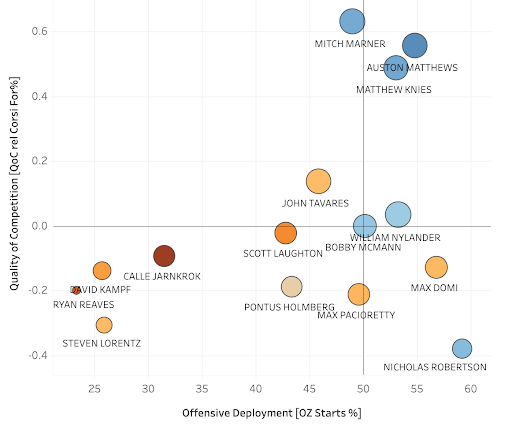
The Leafs’ top line faced highly difficult matchups and was counted on for everything, while the second line also played against top-six lines. There were then two depth lines, one of which was exclusively a checking line.
In St. Louis, Berube was able to free up several scorers with specific offensive-zone deployment (those names in the top right quadrant). Of note, the Leafs were 30th in the league in offensive-zone faceoffs last season. They didn’t possess a third line to soak up some of those difficult starts to free up their top scorers.
GM Brad Treliving has hinted at shifting the deployments this season, specifically around deploying Nic Roy as a checking center, similar to Winnipeg’s usage of Adam Lowry. The Jets’ deployment chart looked like this at forward last season:
In theory, the Leafs want their deployment to break down like so:
- Auston Matthews’ line: will face tough matchups, will see offensive opportunities
- John Tavares’ line: an offensive line
- Nic Roy’s line: a proper checking line
- Scott Laughton’s line: a bottom-six line that can check and score
The best combinations remain to be seen, but this represents a clearer plan compared to last season, when the top line did everything and every line below them did progressively less.
Striking the right balance in 2025-26
While the forward group is receiving all the attention in Toronto — it is the only unit that really changed from last season — the biggest difference between Berube’s Cup-winning Blues team and the Leafs of today is really on defense. There were legitimate stars on the St. Louis defense in Alex Pietrangelo, Jay Bouwmeester, and Colton Parayko. It was a true embarrassment of riches:
Edmundson – Pietrangelo
Bouwmeester – Parayko
Gunnarsson – Bortuzzo
While we can talk until we’re blue in the face about the Leafs’ forecheck and their need to cycle better, they also need to do a better job of getting pucks out defensively. This will be a fine line to walk.
The Leafs surrendered the third-fewest goals at five-on-five in the league and owned the best mark in the Eastern Conference, edging out even the Panthers. The main reason they finished only eighth overall in goals against is their penalty killing mediocrity for large stretches of the season.
It wouldn’t make sense to completely unravel the Leafs’ defensive approach of 2024-25. As stated, they packed the house really well and blocked the fifth most shots in the league. Their goalies were really good, but the players in front of them helped them succeed, too. The defense as a unit is huge, clears the net really well, and is genuinely tough to score against.
However, too often, the Leafs were content to pack the house. For large stretches, five-on-five looked more like a penalty kill as the Leafs wouldn’t aggressively pursue the puck to create turnovers and halt offensive sequences. They’d hang back and let it happen as long as the puck was on the perimeter.
The goal now is a happy medium where they still protect the house really well, but are better at actually getting the puck back in their end and turning it up ice. Can their wingers play a little tighter to the point, and can their defense more aggressively close space and knock pucks free as a result? Can they accomplish both of those goals without conceding more goals against?
Ultimately, there is too much quality veteran talent on this Leafs team to be among the worst in the league at controlling the play. There were far too many games where they were too content to get outplayed for full periods at a time; Craig Berube would often note afterward that his team weathered the storm. The Leafs made no concessions this summer about wanting to contend this season, and the league’s contenders don’t look to weather storms with regularity; they set out to dominate games.
I’m sure we’ll spend lots of time this preseason debating the right line combinations – and I think the initial lines Berube has put on the ice are the correct ones, for what it’s worth! — but none of it matters if the Leafs can’t dictate games better. This falls on the coaching staff more than anything; they had the personnel to be better at it last season, and they made changes to further align the personnel with the coach’s vision this past offseason.
That includes the hiring of new assistant coach Derek Lalonde, who was pretty vocal as a member of the media last season regarding the Leafs’ inability to control play. He has won multiple championships behind the bench of a Tampa Bay team that was very effective at five-on-five possession, so he’s experienced the winning side of what it can look like.
This 2025-26 Leafs season holds all sorts of intrigue, as it’s a new look for the first time in ages and one of the deepest groups the team has entered camp with in this era, including a high-end goalie tandem. But the biggest change shouldn’t come in the form of personnel or line combinations. The 2025-26 Leafs will need to find a way to control the puck and dominate games at five-on-five, similar to the perennial top contenders.















![John Gruden after the Leafs prospects’ 4-1 win over Montreal: “[Vyacheslav Peksa] looked really comfortable in the net… We wouldn’t have won without him” John Gruden, head coach of the Toronto Marlies](https://mapleleafshotstove.com/wp-content/uploads/2025/09/gruden-post-game-sep-14-218x150.jpg)








